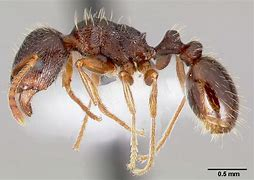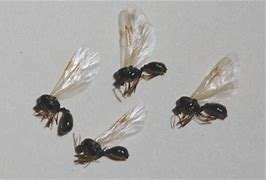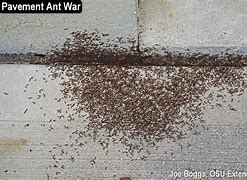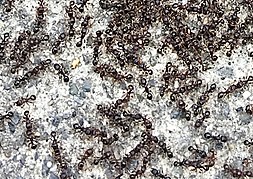Pavement Ants…Pounding the Streets
Background
The pavement ant, also known as the immigrant pavement ant and the sugar ant in parts of North America, is actually native to Europe and was introduced into North America. Its common name comes from the fact that colonies usually make their nests under pavement. This is one of the most commonly seen ants in U.S., being well adapted to urban and suburban habitats. It is distinguished by one pair of spines on the back, two nodes on their petiole(s) (technical jargon for their narrow waist), and grooves on the head and thorax.

Courtesy of Wikipedia
During the late spring and early summer, colonies attempt to conquer new areas and often attack nearby enemy colonies. This results in huge sidewalk battles, sometimes leaving thousands of ants dead. In summer, the ants dig out the sand between the pavements to vent their nests. Obviously not found in space, pavement ants were studied on the International Space Station in 2014.
Overall Description
The pavement ant is dark brown to blackish, and up to ¼ inch long. A colony is composed of workers, alates, and a queen. Workers do have a small stinger, which can cause mild discomfort in humans but is essentially harmless. Alates, or new queen ants and drones, have wings, and are at least twice as large as the workers.

Courtesy of apps.extension.umn.edu
Pavement ant’s mating (nuptial) flights occur in spring and summer; queens and drones leave the nest and find a mate. The drone’s only job is to mate with the virgin queens. The dealate, or newly fertilized queen, sheds her wings, finds a suitable nesting location and digs a founding chamber called the claustral chamber or secluded cell. The queen must raise the first generation of young herself until they are old enough to forage for food. During this period, she survives by metabolizing the proteins of her flight muscles. As the eggs hatch and the ants develop, they spend that time, about two to three months, tending to the queen of their colony. They will continue helping in the colony until they are a month old.
Older workers forage for food and defend the colony. They will eat almost anything, including other insects, seeds, honeydew, honey, bread, meats, nuts, ice cream and cheese. Although they do not usually nest inside buildings, they may become a minor nuisance entering homes attracted by food left out. They are also predators of certain moth larvae.
Habitat
Pavement ants build underground nests, preferring areas with little vegetation, and have adapted to urban areas, being found under building foundations, sidewalks, pavements, and patios. Nests can occupy an area of 13 to 52 sq. ft. and are 18 – 36 inches deep. They may be identified by entrance holes surrounded by small crater-shaped mounds of sand in summer. Colonies may have 3,000 to over 10,000 workers, and are usually monogynous, having one queen, or in rare cases two or more.

Courtesy of OSU.edu

Closeup of battling ants…Courtesy of OSU.edu.
They often defend a territory, estimated at hundreds of square feet, and large battles between neighboring unrelated colonies are common, especially in spring when new colonies are establishing their boundaries. A closeup of battling ants can be found in the image above with opposing ants having their mandibles clasped onto each other.
Threats
Black pavement ants do not pose a public health risk, but they can contaminate food and should be avoided. If you notice pavement ants in your property, you should contact Millette Pest Control for inspection, treatment, and preventive guidance.
Pavement Ant Prevention
Pests, such as pavement ants, are attracted to moisture. To prevent black pavement ants, eliminate standing water around the home. Keep tree branches and other plants cut back from the house. Sometimes pavement ants use these branches to get into your home. Make sure that there are no cracks or little openings around your house; seal these to prevent entrance. Make certain that firewood and building materials are not stored next to your home because pavement ants like to build nests in stacks of wood. Indoors, clean up spills and crumbs on counter tops and kitchen floors.
